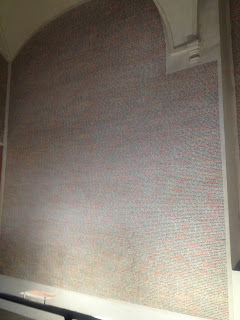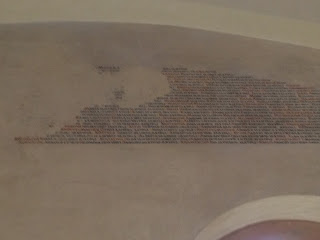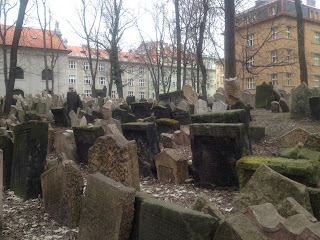4/3
Congratulations! Chances are, if you have stuck with these posts for this long, you are either: 1) someone who loves me very much, 2) someone very interested in European travel, 3) someone with lots of free time on your hands! I know I have filled these posts with much deatil, and many stories that might not be interesting to everyone. True confessions: part of my reason for doing this is to share our experiences with friends and family, but part of it is for us, to help us remember and relive the excitement and thrill of a trip in which we packed so much in, a lot of it has become a blur. So, as I write these posts, I get to relive the excitement and thrill that was this trip, and definitely invite you to join me!If it's too much detail--feel free to just scan the photos or read as much or as little as you care to!
We began today with another run, this time taking the other
fork in the path, and going along the base of the hill. No particularly
wonderful views, but it’s always fun to run in a new place, and nod to the few
other hardy souls who were out there in the cold! The tourist part of the day
began in the somewhat underwhelming Wenceslas Square, starting at the top at
the National Museum and the Opera House, and wandering down the trendy shopping
district. The wide boulevard was supposed to be a pedestrian zone in the style
of a Paris street with the highway directed underground, but that still is in
progress, and a major highway passes right by, so the façade of the museum is covered by a thick layer of exhaust
soot. The ‘Big Dig” (shades of Boston?) is supposed to be finished in 2014. Wenceslas Square was
the scene of many important events in Czech history. In 1969, a philosophy
student immolated himself, hoping to spark a freedom movement. While this was
suppressed by the communists, his actions did have an impact. On the 20th year anniversary of this
death, a new student protest to commemorate his death was far more
“successful”, leading, 10 months
later, to the fall of the Communist government. The scene must have been an
amazing one: 300,000 people packed into the square one day after another, listening to a rock star, a
poet and Vaclav Havel (a playwright and leader of the freedom movement),
speaking from the balcony and clinking their keys, chanting “It’s time to go
now”. Gorbachev, seeing the writing on the wall, instructed the government to
let this protest happen, and eventually Havel was elected the country’s first
President.
 |
| National Museum |
 |
| So many cars! |
 |
| Good King Wenceslaus |
 |
| Mucha mural on the building |
 |
| Apparently, Budweiser was originally Czech! |
 |
| Opera House |
If yesterday was the castle and the Christians houses of
worship, today was dedicated to the Jewish Quarter, and the rich, vital, if
troubled and haunting history of the Jewish Community in Prague. The Jewish
Museum consists of 7 different sites: 5 synagogues, the cemetery, and the
building that housed the headquarters of the Burial Society. We began in the
Pinkas Synagogue, used as a house of worship in the 1500’s, but now a memorial
to the Czech victims of the Holocaust. The sight is sobering and
incomprehensible: the names of the Jews of Prague and the surrounding area are
painted on the walls—the writing is small and the walls are completely covered
with names. It gives a small glimpse into the huge number of those exterminated
by the Nazis. The names were erased during the Communist regime, but rewritten
after the Czechoslovakia gained independence; the original writing remains on
one wall, so they were able to copy the style of the script. Upstairs was an exhibit of the Art of Terezin,
the camp to which most f the Czechs were originally deported. Later, they too were
sent to the Extermination Camps, but in the beginning, they were mostly in this
“show” camp. Artist from the community worked with the children to help them
process the horrors they were experiencing through art.
 |
| The names of Czech citizens killed in the Holocaust |
 |
| Only remains from the original writing |
The Jewish Cemetery was next—Jews were only allowed to be buried in this very small plot of land, and there wasn’t nearly enough room to accommodate all the bodies, so they are buried 11 and 12 deep, each body with tombstone. Over the years, the ground shifted, creating the jumble of fallen and toppled stones seen today. It is an incredible sight!
 |
| Jewish Cemetery |
Next was the house of the Burial Society. In the Jewish
community the members of this society were people of great influence and played
an extremely important role—they accompanied the sick and dying in their last
hours, heard their final prayers, prepared the coffins, bodies and ground for
the burial, performed the ceremony, and accompanied the mourners. The building
housed artifacts used in these roles, as well a series of paintings
representing the entire cycle from illness to the end of the mourning period.
It was fascinating! Next was the Klaus Synagogue, built in the late 17th Century, and housing extremely informative and interesting displays describing
Jewish life, accompanied by artifacts: holidays, the cycle of Jewish life and
rites (circumcision, Bar Mizvah, weddings etc.).
The oldest synagogue in all of Europe still in use today is
the “Old –New “Synagogue, built in the 1200’s and still in use today by the
small remaining Jewish Community in Prague. There were a number of elderly
women there who offered any explanations we needed—I asked a 91-yar-old woman
what happened to her in the war. Her story was somewhat rambling, but what was
clear is the fear she has that something like the Holocaust could happen again.
It’s the never-ending dilemma; freedom of speech means that anyone gets to say
what they think, even those whose views are hateful and discriminatory.
The Maisel Synagogue, built in 1519 as a private house of
worship, was used by the Nazis as a storage place for all of the art stolen
from the Czech Jews during the war. It was all catalogued and organized, as the
Nazi’s plan was to create a museum of the extinct Jewish people—absurd and
eerie, isn’t it? Now the building houses a very detailed and informative
history of the Jewish people of the area—amazing how through their history,
people really hated the Jews! They were more often than not, only allowed
careers as money-lenders, which perpetuated their image as greedy and causing
great animosity among those who were forced to borrow from them. They enjoyed a
very brief period of prosperity during the Enlightenment, but this came to a
very abrupt and tragic end with Hitler’s rise to power. We ended the day with
the most glamorous and exquisite building of all, the Spanish Synagogue, built
in 1868 in Moorish style. The inside is stunning—golds, crimsons and blues set
off the dark brown background, and the painting is so ornate and gorgeous. The
exhibits housed here continued the history of the Jews from where it left off
in the other synagogue, post WWII when Anti-Semitism turned to Anti-Zionism,
there was a brief period of support for the new Jewish State in the hopes that
it would be Communist, followed by a breaking off of that relationship when
that didn’t turn out to be the case. This was also the first reform synagogue
in Prague, as can be seen by the organ, as well as the texts of the service in
German (the language spoken by the Czech Jewish Community.) The beauty of this
place really can’t be captured in photos.
By the time we got out of the Jewish Quarter it was time to
find some food, and Rick Steves was right on the money with his recommendation
of a really good, really cheap place serving Czech specialties. We decided not to eat at "Kafka Snob Food", though we did admire the Kafka statue--Kafka having been a resident of the quarter. A bit more
wandering, a last trip to buy groceries and an evening in the room packing and
organizing for the trip to Bratislava tomorrow ended the full day.











































No comments:
Post a Comment